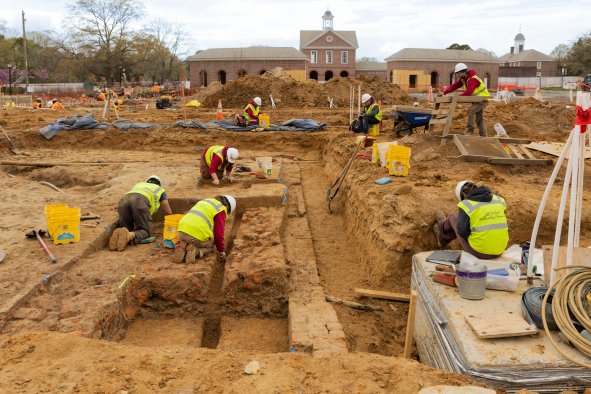Scientists are unraveling the secrets of a Bronze Age hoard containing jewelry that is thought to have been buried around 3,000 years ago.
The hoard was discovered in Rosemarkie, a village in the Scottish Highlands, during excavations conducted before the development of several new homes, GUARD Archaeology announced. The site is home to the remains of a prehistoric settlement—a Bronze Age village comprising at least six roundhouses and also a stone grave.
The pit containing the hoard was removed in its entirety during the excavation and subsequently transported to GUARD's Finds Lab in Glasgow, Scotland, Ronan Toolis, CEO of the archaeological services company, told Newsweek.
Now, laboratory investigations carried out by GUARD have shed new light on the discovery, revealing a total of nine bronze artifacts: one complete neck ring, one partial neck ring, six penannular (in the form of an incomplete circle or ring) bracelets and one cup-ended penannular bracelet. Experts also identified preserved plant material that was fashioned into fibrous cords and tied around some of the bronze objects.
"Most of the bronze artifacts and some of the plant remains were visible prior to our lab work. But the twisted cords used to tie some of the artifacts together only became apparent during our lab excavation," Toolis said.
Specialist analysis of the plant remains has yet to be completed, so the specific species in question has yet to be determined.
Given their appearance, the metal artifacts are estimated to date to the Late Bronze Age—around 1000 B.C. But specialist analysis will confirm this, along with radiocarbon dating of the organic remains associated with the hoard, according to Toolis.
"What makes the hoard especially significant is that it was not an isolated find with little context to explain it but was discovered within the middle of a prehistoric settlement," Toolis said. "Altogether, GUARD Archaeology's analysis of these archaeological remains will shed light upon the lives, beliefs and deaths of Bronze Age highlanders."
He went on: "While there are other examples of hoards where it has been postulated that items were bound together due to their positioning, the plant cords in the Rosemarkie hoard prove that these artifacts were held together."
The survival of the organic remains can likely be explained, in part, by the antimicrobial properties of copper, which is present in bronze.
Rachel Buckley, who led the laboratory excavation, said in a GUARD press release: "The recovery of the artefacts was successfully carried out under the controlled conditions necessary to preserve these highly significant objects, particularly the very delicate organic cords that tether some of the objects together."
Over the next few months, experts will examine the various pieces of archaeological evidence in an attempt to explain why the hoard may have been buried in Rosemarkie.
"That the hoard was buried under a single homogenous fill within a shallow pit with little extra room for anything other than what was found within indicates that this was no accidental loss," said Iraia Arabaolaza, who is managing GUARD Archaeology's analyses.
"It would seem that the shallow pit was dug to the required length and depth to accommodate the items before then being quickly backfilled," Arabaolaza continued. "It may be that it was intended as temporary storage with the intention of recovering the hoard at some stage. The evidence from the surrounding settlement may reveal whether it was not just the hoard that was abandoned but the settlement as well."
Do you have a tip on a science story that Newsweek should be covering? Do you have a question about archaeology? Let us know via science@newsweek.com.
Disclaimer: The copyright of this article belongs to the original author. Reposting this article is solely for the purpose of information dissemination and does not constitute any investment advice. If there is any infringement, please contact us immediately. We will make corrections or deletions as necessary. Thank you.



